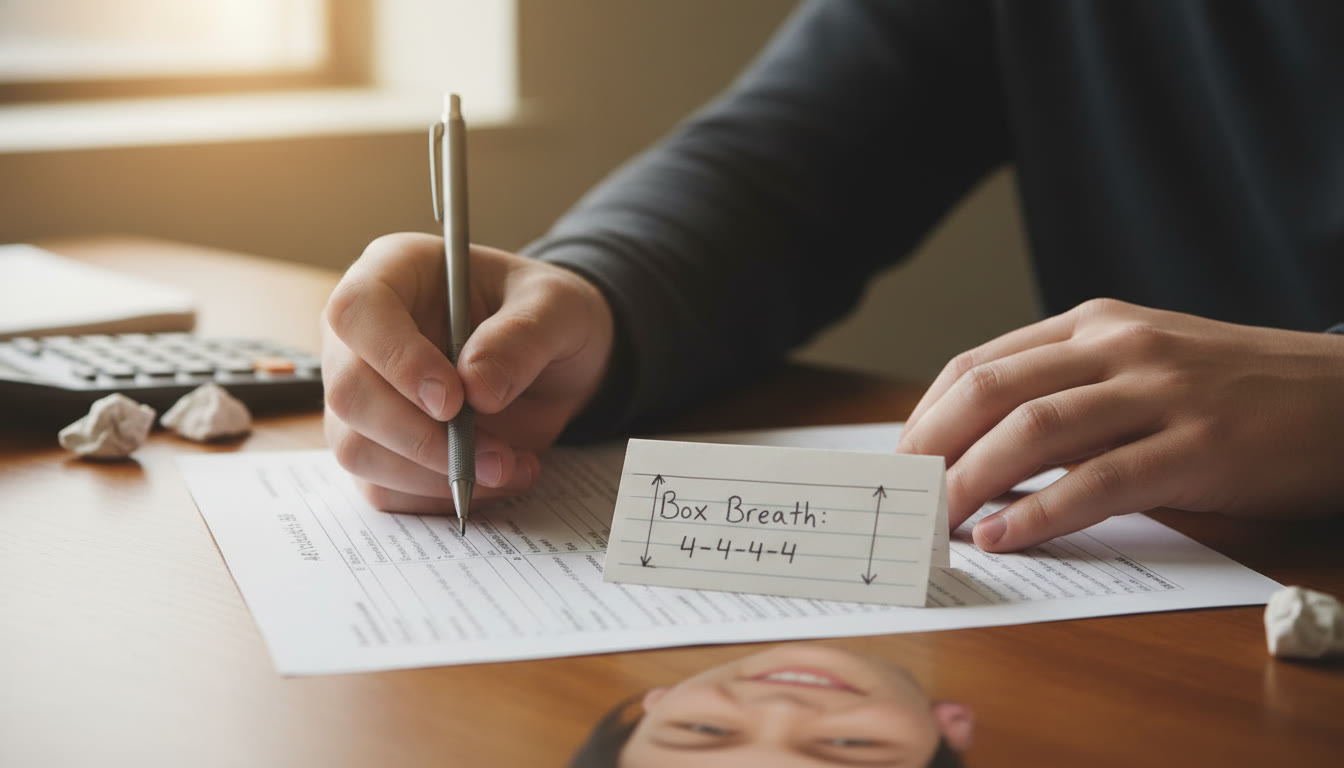Why Breathing Matters Before an AP Exam
Walk into any crowded testing room and you’ll feel a shared energy—anticipation, nervousness, and a hum of focused intensity. For students preparing for AP exams, that hum can quickly become a loud, intrusive chatter inside your head: What if I blank? What if I run out of time? What if I don’t remember that formula? It’s totally normal. But your body responds to that mental noise in deeply physical ways—fast heart rate, shallow breaths, tense shoulders. The surprising power you have to change that reaction lies in something you already do every second: breathe.
Breathing isn’t just an automatic function that keeps you alive. It’s a fast-acting lever you can use to shift your nervous system from fight-or-flight to a calmer, more focused state. Small, intentional breath changes influence heart rate, attention, and mood. That’s why brief, reliable breathing routines can be one of the most dependable tools in your AP prep toolkit—portable, zero-cost, and scientifically rooted in how physiology and attention interact.

Quick Science, No Jargon: How Breath Calms You
When you breathe slowly and fully, you activate the parasympathetic nervous system—the body’s “rest and digest” response. This helps slow your heart rate and reduce adrenaline. On the flip side, short, rapid breathing signals the sympathetic nervous system, ramping up alertness and anxiety. The good news: breathing gives you direct, immediate access to both systems.
That means a 60-second, intentionally paced breathing exercise can reduce the physiological symptoms of anxiety and make your thinking clearer. For AP tests—where clarity, calm, and controlled attention matter—those 60 seconds can translate into better problem-solving, fewer careless errors, and a steadier confidence as you turn the page.
When to Use Breathing Routines
- Before the exam starts: in the parking lot, hallway, or outside the testing room.
- Right before you open the paper: pause, breathe, and ground yourself.
- During difficult sections: 20–60 seconds in the restroom or at your seat (if allowed) to reset attention.
- After a tricky question: brief breathing stops rumination and prevents panic from spreading.
- During the final 10 minutes: steady breathing helps with pacing and error checking.
Three Simple Routines You Can Learn Today
These routines are intentionally short and easy to practice. Try them while studying so they become second nature on exam day.
1. Box Breath — The Reliable Reset (60–90 seconds)
Why it works: Box breathing regulates inhale and exhale lengths, which calms the nervous system and brings immediate focus.
- How to do it: Inhale for 4 counts, hold for 4 counts, exhale for 4 counts, hold for 4 counts. Repeat 4 times.
- When to use it: Right before entering the room or after a surge of panic during the exam.
- Tweak: If 4 counts feels short or long, adjust to 3 or 5 counts to match comfortable lung capacity.
2. 4-6-8 Calm Breath — Slow Down, Deepen Focus (60–120 seconds)
Why it works: Longer exhalations stimulate relaxation pathways. This pattern increases feelings of calm while maintaining alertness.
- How to do it: Inhale for 4, hold for 2, exhale slowly for 6 (or 8 if comfortable). Repeat 5–8 cycles.
- When to use it: When your heart is racing or you feel overwhelmed before a timed section.
- Tweak: Use a soft mental counting or whisper-count to avoid disturbing other students.
3. Diaphragmatic (Belly) Breath — Ground and Center (90 seconds)
Why it works: Many of us breathe shallowly into the chest. Belly breathing shifts the work deeper into the diaphragm, increasing oxygenation and reducing tension in the shoulders and neck.
- How to do it: Place one hand on your chest and one on your belly. Inhale so the belly rises while the chest stays still. Exhale slowly and feel the belly fall. Repeat 8–12 times.
- When to use it: Any time—especially helpful in the minutes leading up to the exam or during a break in studying.
- Tweak: Add a counting cue, e.g., inhale 1-2-3, exhale 1-2-3-4. The longer exhale increases calm.
Sample Pre-Exam Routine: A 10-Minute Calm Plan
This routine is designed to be practical on test morning. It combines breathing with small rituals that prepare both body and mind without overloading you right before you sit down.
| Time Before Exam | Action | Why It Helps |
|---|---|---|
| 10 minutes | Quiet diaphragmatic breathing (90s), light stretch, sip water | Releases tension, hydrates, signals to brain that you’re caring for yourself |
| 7 minutes | Box breathing (60–90s) | Sharpens focus and stabilizes nervous system |
| 5 minutes | Positive reminder: 2 quick affirmations (e.g., “I prepared. I can handle this.”) | Reduces catastrophic thinking and centers intent |
| 3 minutes | Slow 4-6-8 breath (60s) | Clears residual nervous energy and steadies heart rate |
| 1 minute | Place testing supplies on desk, take a final slow breath, open the packet calmly | Creates ritual and reduces last-minute fumbling |
Practical Tips to Make Breathing Work for AP Prep
Practicing breathing when you’re calm builds a stronger conditioned response for exam day. Think of it like training a muscle: the more you practice the pattern, the faster it will take effect when you need it.
Practice Often, Not Just the Night Before
Integrate a two-minute breathing break into your study sessions—after a timed practice exam, between review blocks, or when switching subjects. This trains your brain to pair the breath pattern with a shift to clarity and focus.
Use Small, Portable Reminders
- Write the steps of your favorite routine on an index card and slip it into your calculator case or notebook.
- Practice the box breath while standing in line at school or waiting for the bus.
Combine Breath with Active Study Strategies
After completing a spaced-practice session, take 90 seconds of diaphragmatic breathing to consolidate focus and reduce mental fatigue. Over time this pairing helps you learn while maintaining calm.
Simulate Test Conditions
Do at least one full practice test where you intentionally use your breathing routines during breaks and after any spike of anxiety. This builds confidence in your ability to reset mid-exam without losing time or focus.
Real Student Example: How a Breathing Habit Changed One AP Journey
Feelings of anxiety are common—here’s a composite example based on real student experiences. Mia, a junior taking AP Physics, noticed that she would freeze on long free-response questions because her breathing became shallow and panicked. After practicing the 4-6-8 breath before timed sections and using a single box-breath reset after a stressful problem, she reported fewer blank moments and better pacing. Those small adjustments changed how she approached the entire paper—less urgency, more steady problem-solving.
Common Concerns and How to Handle Them
Q: “Will breathing take too much test time?”
A: No. The breaths suggested are short—60 to 120 seconds at most. That investment often saves time because it prevents mistakes that come from panic. Practiced well, a single 30–60 second reset can be enough to regain composure without losing momentum.
Q: “What if I get lightheaded?”
A: If a breathing pattern makes you dizzy, slow the pace and shorten the counts. Focus on gentle diaphragmatic breathing rather than forcing long inhales or exhales. The goal is calm, not hype.
Q: “How can I practice when I’m overwhelmed with revision?”
A: Fold breathing into your revisions—use it between subject blocks, after practice questions, or right after reviewing a concept you found hard. Think of breathing as recovery between study efforts rather than extra work you must find time for.
How Tutors and Tailored Support Amplify Breathing Practice
Breathing routines are powerful on their own, but combined with personalized guidance they become even more effective. Working 1-on-1 with an experienced tutor can help you identify the moments where breathing would have the biggest payoff—like before a high-stakes free-response section or when an unfamiliar passage triggers anxiety. Tutors can also help integrate breathing into study schedules so the techniques become automatic rather than an afterthought.
Sparkl’s personalized tutoring model adds a few unique benefits: expert tutors who map breathing routines onto your exam plan, tailored study plans that include short breath-based resets after timed practice, and AI-driven insights that highlight when your practice scores dip due to time pressure or anxiety. When breathwork is part of an individualized plan, it stops feeling like an extra thing to remember and starts functioning as a reliable tool embedded in your test strategy.
Two Complete Ready-Made Routines for AP Students
Below are two practical routines you can print, memorize, or add to your phone notes. Try them in practice tests and tweak counts to suit your comfort.
Routine A — Morning of the Exam (10–12 minutes)
- 3 minutes: Gentle stretch, shoulders and neck rolls.
- 2 minutes: Diaphragmatic breathing (hand on belly), 8–10 breaths.
- 2 minutes: Box breathing, 4 cycles (4-4-4-4).
- 1 minute: Positive micro-affirmation and visualizing opening the test packet calmly.
- 2–3 minutes: Pack supplies, slow 4-6-8 breath once more before final steps into the room.
Routine B — Mid-Exam Reset (30–90 seconds)
- Step away (or lower your head if you must remain seated).
- 30–60 seconds: 4-6-8 breath—inhale 4, hold 2, exhale 6 (or 8).
- 10–30 seconds: Reframe: “I will do the next question step-by-step.”
Tracking Progress: A Tiny Journal to Measure Impact
Breathing feels subtle—use a short log to see its effects. After each practice test or study block, note two things: (1) Which breathing routine you used, and (2) One measurable outcome (e.g., “fewer careless errors on multiple-choice,” “faster return to focus after a hard problem”). Over a few weeks you’ll see patterns and know which routine fits specific moments.
Putting It All Together: Your Personalized Action Plan
1) Choose your go-to routine (start with box breathing or diaphragmatic). 2) Practice it daily—during study breaks and once in the evening. 3) Simulate in practice tests so it’s seamless on exam day. 4) Use a tutor or mentor to fold breathing into your timing strategy and stress points—Sparkl’s 1-on-1 guidance and tailored study plans can help you slot these routines into the exact moments where you’ll need them most. 5) Keep a brief log for two weeks and refine counts and timing based on what helps you feel steadier and make better choices under pressure.
Final Notes and Encouragement
AP exams ask a lot of you, but you don’t have to meet that demand only with raw willpower. Simple physiological shifts—like a steady, intentional breath—are practical, immediate, and often surprisingly effective. The beauty of breathwork is that it restores two things tests often steal: clarity and confidence.
If you’re curious about making breathing a consistent part of your AP strategy, start tiny: one minute after your next study block. If you’d like help weaving breathing into a study plan that fits your class schedule and exam goals, consider working with a tutor who can personalize timing and cues—Sparkl’s tutors can pair these practices with targeted AP content review and AI-driven practice insights so that calm becomes a reliable part of how you perform.
Walk into the exam room knowing you’ve prepared not only your brain, but your body. Take a breath. You’ve got this.

























No Comments
Leave a comment Cancel